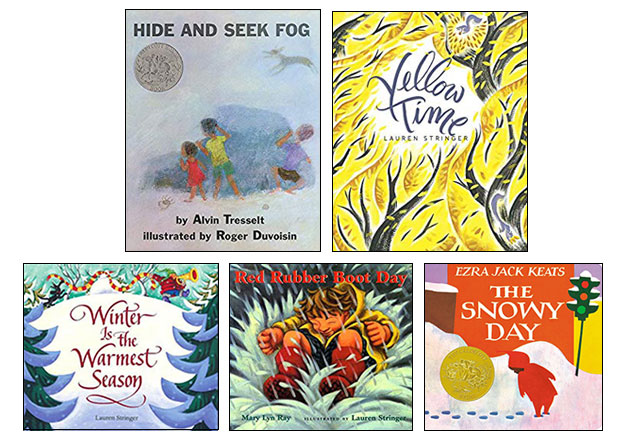Phyllis: Minnesota has had a winter full of weather this year. We’ve just finished the snowiest February on record, and now March is blowing down on us with the promised of wind and rain and (most likely) still more snow. An anonymous British poet wrote of the weather, “We’ll weather the weather whatever the weather.” We decided to not only weather the weather but to celebrate it with a few weathery picture books.
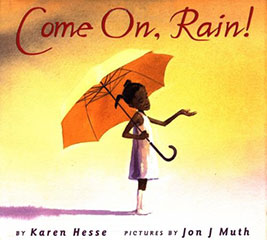 In Karen Hesse’s Come On, Rain, illustrated by Jon J. Muth, an urban African American child yearns for rain. Her mamma’s plants are parched, She is “sizzling like a hot potato,” and the city droops with heat. Hope comes in gray clouds rolling in, and the narrator runs to find her friend Jackie-Joyce and tell her to put on her swimsuit. They run out into the alley, where their friends join them, and raindrops plop down, “making dust dance all around us.” The friends dance in circles, open their mouths to catch the rain, chase each other down the street. They make such a racket shouting, “Come on, rain!” that the grown-ups toss off their shoes and socks and join them in a joyous celebration. When the clouds and rain at last move off and everything is “springing back to life,” they head home soaked and soothed by the welcome rain. I remember the delight of running out into my back yard into a rainstorm, puddle-jumping, raindrop catching, and rainbow spotting. Hesse’s book makes me wish for a rainstorm right now so I could run out into one again.
In Karen Hesse’s Come On, Rain, illustrated by Jon J. Muth, an urban African American child yearns for rain. Her mamma’s plants are parched, She is “sizzling like a hot potato,” and the city droops with heat. Hope comes in gray clouds rolling in, and the narrator runs to find her friend Jackie-Joyce and tell her to put on her swimsuit. They run out into the alley, where their friends join them, and raindrops plop down, “making dust dance all around us.” The friends dance in circles, open their mouths to catch the rain, chase each other down the street. They make such a racket shouting, “Come on, rain!” that the grown-ups toss off their shoes and socks and join them in a joyous celebration. When the clouds and rain at last move off and everything is “springing back to life,” they head home soaked and soothed by the welcome rain. I remember the delight of running out into my back yard into a rainstorm, puddle-jumping, raindrop catching, and rainbow spotting. Hesse’s book makes me wish for a rainstorm right now so I could run out into one again.
Jackie: I love this book, too, for that feeling of a growing celebration that’s going to bring the whole neighborhood together. And it reminds me of the fun of being drenched by a warm rain. It always gives me a feeling of being one with the world to be out in the rain, just getting wet. I laugh at how even the dust dances in celebration in this story.
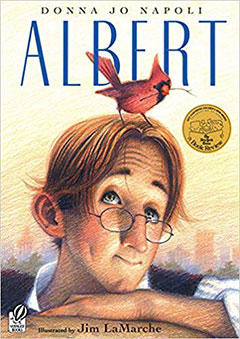 Phyllis: Albert by Donna Jo Napoli, illustrated by Jim LaMarche, is less about a particular kind of weather and more about a man who only experiences the weather by sticking his hand out the grillwork over his window, deciding it’s too cold, too damp, too hot, or too breezy to go outside.
Phyllis: Albert by Donna Jo Napoli, illustrated by Jim LaMarche, is less about a particular kind of weather and more about a man who only experiences the weather by sticking his hand out the grillwork over his window, deciding it’s too cold, too damp, too hot, or too breezy to go outside.
One day when he sticks his hand out, a cardinal drops a twig in it, then another cardinal joins in. While Albert watches, they build a nest in his hand and settle in. Albert doesn’t want to disturb the nest by twisting his hand back in through the grillwork, so he stands there, holding the nest, which soon contains eggs. Kind-hearted Albert sleeps standing up at night, breathing on the eggs to keep them warm whenever the mother leaves the nest, and scaring away a curious cat, all the while watching life go by on the street below. One morning “when Albert opened his mouth, he peeped.” The father cardinal brings him a beetle, then blackberries to eat. On the twelfth morning the eggs hatch, and within a few weeks the hatchlings fledge, eventually leaving the nest, the last with encouragement from Albert. He lets the now empty nest fall, pulls his hand back in, and realizing that he is part of the big wonderful world, whether cold or damp or hot or breezy, he heads out of his apartment. The book ends: “Now Albert walks often. And sometimes, just sometimes, when no one’s looking, he flies.” The art shows Albert soaring on a swing, a cardinal perched on his head. This is a book that invites us not only to be generous and kind to animals but also to step out into the “big wonderful world” of which we are all a part.
Jackie: And if we are lucky, perhaps sometimes we will fly. My used copy of this book is signed by the illustrator Jim LaMarche. The cardinals he drew for this book are so wonderful. They look as if they might fly right off the page. Readers of this story may never have a nest on their hands, but they will never see cardinals the same again.
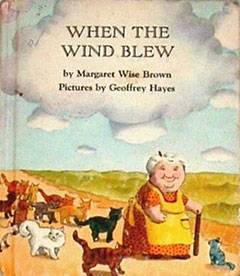 Phyllis: Two books about wind seem fitting for March, which has come in like a snow lion this year. In When the Wind Blew by Margaret Wise Brown, illustrated by Geoffrey Hayes, an old, old lady lives all by herself by the ocean with seventeen cats and one little blue gray kitten. Each morning the old lady milks her cow and fills seventeen purple saucers and one little blue saucer to feed her cats and kitten, then fills a mug for herself. The old woman washes up the dishes, the cats wash themselves, and they all enjoy the sunshine. One day the wind blows off the ocean, and the old lady brings her cats and kitten in out of the wind, where they curl up by the fire. Then a terrible toothache strikes her, for which she has no medicine or even a hot water bottle to put on her toothache for the pain. She takes her toothache to bed and listens to the wind tearing through the cracks in her house, wishing for a hot water bottle for her aching tooth. Click purr, click purr. The little blue gray kitten jumps onto the bed and curls up next to her cheek, a fur-covered hot water bottle that takes her toothache away. The wind blows on, but the old lady and her cats and blue grey kitten all sleep peacefully in her little house by the ocean. A simple tale, and a comforting one, with Margaret Wise Brown’s loving attention to the simple details of everyday life.
Phyllis: Two books about wind seem fitting for March, which has come in like a snow lion this year. In When the Wind Blew by Margaret Wise Brown, illustrated by Geoffrey Hayes, an old, old lady lives all by herself by the ocean with seventeen cats and one little blue gray kitten. Each morning the old lady milks her cow and fills seventeen purple saucers and one little blue saucer to feed her cats and kitten, then fills a mug for herself. The old woman washes up the dishes, the cats wash themselves, and they all enjoy the sunshine. One day the wind blows off the ocean, and the old lady brings her cats and kitten in out of the wind, where they curl up by the fire. Then a terrible toothache strikes her, for which she has no medicine or even a hot water bottle to put on her toothache for the pain. She takes her toothache to bed and listens to the wind tearing through the cracks in her house, wishing for a hot water bottle for her aching tooth. Click purr, click purr. The little blue gray kitten jumps onto the bed and curls up next to her cheek, a fur-covered hot water bottle that takes her toothache away. The wind blows on, but the old lady and her cats and blue grey kitten all sleep peacefully in her little house by the ocean. A simple tale, and a comforting one, with Margaret Wise Brown’s loving attention to the simple details of everyday life.
Jackie: One of her details is the detail of pain. “Her toothache was all there seemed to be in the world.” And I love the verbs that MWB uses. The cats, “mewed and purred and gurgled for breakfast.” And the wind that “blew the sunlight cold and almost blew the little gray kitten off his feet.” We have had those winds that blow the sunlight cold. This book is a peek into a self-contained world that gets blown awry and then righted and it is so satisfying.
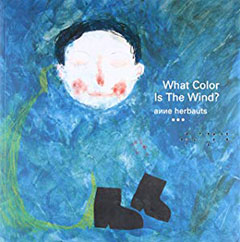 What Color is the Wind? by Anne Herbauts is a lyrical meditation on the wind, but it is also a textural book. By running one’s fingers over the pages one can feel the ruffled hair of a dog, the coarse fur of a wolf, the raised bumps of rain, the smooth skin of an apple. Combine this with cut out windows, and you have a book to fascinate the senses. In the story, a little giant of a child sets out to discover the color of the wind, only to receive different answers from the animals and objects that he meets. Stream, tree, bird all weigh in, but it is an enormous giant who answers, “It is everything at once. This whole book.” Ruffling the pages of the book the enormous giant makes a gentle wind for the little giant. The wind of the book. Magical.
What Color is the Wind? by Anne Herbauts is a lyrical meditation on the wind, but it is also a textural book. By running one’s fingers over the pages one can feel the ruffled hair of a dog, the coarse fur of a wolf, the raised bumps of rain, the smooth skin of an apple. Combine this with cut out windows, and you have a book to fascinate the senses. In the story, a little giant of a child sets out to discover the color of the wind, only to receive different answers from the animals and objects that he meets. Stream, tree, bird all weigh in, but it is an enormous giant who answers, “It is everything at once. This whole book.” Ruffling the pages of the book the enormous giant makes a gentle wind for the little giant. The wind of the book. Magical.
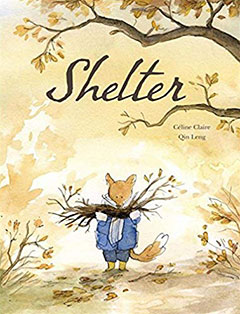 Sometimes a book touches us so much that we have to own it. As soon as I took Shelter by Celine Claire, illustrated by Qin Leng off the shelf at Red Balloon Bookshop and read through it, I knew I could not leave the store without it. The book begins with animals preparing for a coming storm, gathering wood for the a fire, squirreling away nuts. As the storm hits and the animals are snuggly tucked in their dens, two strangers, a big bear and a little bear, appear in the fog seeking shelter. They offer tea in exchange for the warmth of a fire at the first den they come to, and though the art shows a brightly burning fire, the animals inside claim their fire is out. “Try next door,” they say. Next door the hungry bears offer to trade tea for a few cookies but are told, “We have no food. Try next door,” even though the den is heaped with acorns. The foxes next door turn the bears down because their den is crowded, although Little Fox runs after the bears and offers them a lantern. Next door is only a hill, but the bears feel welcome there, and once snow begin to fall, they know they will be all right. Back in the foxes’ den, the weight of the snow causes the roof to collapse, and although the fox family escapes, the world outside is cold and dark and full of snow. A light beckons, which turns out to be the lantern Little Fox gave the bears, glowing through the snow den they have built. Little Fox offers cookies for tea and the bears reply that their lantern is weakening, their den is small and crowded, and they have no food but the foxes are welcome to share the den and their tea — which they do. The last illustration shows the winter storm blustering while inside the small snow shelter, the foxes and bears sip tea and eat cookies together by lantern light. This story moved my heart, not least because it is about the generosity of strangers and about how we never know when we might be the stranger in need of aid who hopes someone will open their heart to us.
Sometimes a book touches us so much that we have to own it. As soon as I took Shelter by Celine Claire, illustrated by Qin Leng off the shelf at Red Balloon Bookshop and read through it, I knew I could not leave the store without it. The book begins with animals preparing for a coming storm, gathering wood for the a fire, squirreling away nuts. As the storm hits and the animals are snuggly tucked in their dens, two strangers, a big bear and a little bear, appear in the fog seeking shelter. They offer tea in exchange for the warmth of a fire at the first den they come to, and though the art shows a brightly burning fire, the animals inside claim their fire is out. “Try next door,” they say. Next door the hungry bears offer to trade tea for a few cookies but are told, “We have no food. Try next door,” even though the den is heaped with acorns. The foxes next door turn the bears down because their den is crowded, although Little Fox runs after the bears and offers them a lantern. Next door is only a hill, but the bears feel welcome there, and once snow begin to fall, they know they will be all right. Back in the foxes’ den, the weight of the snow causes the roof to collapse, and although the fox family escapes, the world outside is cold and dark and full of snow. A light beckons, which turns out to be the lantern Little Fox gave the bears, glowing through the snow den they have built. Little Fox offers cookies for tea and the bears reply that their lantern is weakening, their den is small and crowded, and they have no food but the foxes are welcome to share the den and their tea — which they do. The last illustration shows the winter storm blustering while inside the small snow shelter, the foxes and bears sip tea and eat cookies together by lantern light. This story moved my heart, not least because it is about the generosity of strangers and about how we never know when we might be the stranger in need of aid who hopes someone will open their heart to us.
Jackie: I agree. This is a wonderful book and so perfect for our time. If one reader shares one cookie with another, who then shares a cookie…Well, let’s hope.
So many more good weather books, some of which we’ve looked at in previous posts—The Snowy Day, Hide and Seek Fog, Lauren Stringer’s Winter is the Warmest Season, Red Rubber Boot Day, Yellow Time—we could keep listing them until the snow melts. Whether or not we like the weather, we’ll weather it with a good weathery book, knowing, too, that if we just wait a little while, new weather will be upon us.
